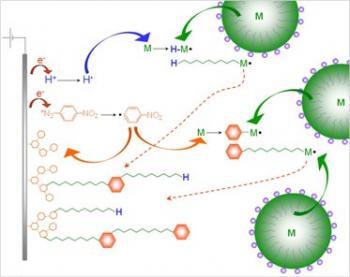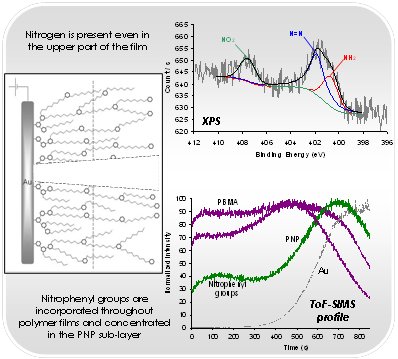

Proposed mechanism for the SEEP process. The 3 steps are highlighted: 1 is the direct electrografting of the diazonium initiator; 2 is the initiation of the radical polymerization of the monomer M; 3 is the termination reaction that grafts the growing chain to the polyphenylene grafted film.
Electrografting of vinylic polymers onto conducting surfaces has historically been achieved via the direct electron transfer from the cathode to the electro-active monomers in solution. The resulting radical-anion, together with the anions that allow the propagation of the growing grafted polymer chains, are highly sensitive to proton sources. The "classical" cathodic electrografting process thus requires strictly anhydrous conditions.
Radical polymerization does not suffer the same drawback and can be performed in aqueous conditions. We thus demonstrated that cathodic electrografting on conducting surfaces can be achieved in protic conditions, provided the polymerization is radically initiated by an electro-active moiety. The best initiators are actually diazonium salts.
We showed that this initiation is efficient and delivers polymer chains from vinylic monomers solubilized within the electrolyte (either directly or in micellar conditions). The resulting polymer chains normally grow in solution or within the micelles, and are eventually terminated by any radical or radical scavenger present in the medium. Among the termination processes, the most interesting is the reaction of the growing polymer chains with the already grafted aromatic rings coming from the direct electrografting of the diazonium initiator. Hence, the diazonium salt acts both as an initiator for the radical polymerization in solution, and as a primer for the chemical grafting of the resulting polymer chains on the surface of the electrode.
Angle-resolved XPS and Tof-SIMS analysis confirmed that the polyphenylene grafted films arising from the direct electrografting of the diazonium moieties are actually located below the vinylic chains, in direct contact with the ele
That new grafting process we called SEEP (Surface Electroinitiated Emulsion Polymerization) allows the formation of truly grafted polymer films from aqueous media, provided suitable surfactants are used to solubilize the polymer precursors. From the mechanistic point of view, SEEP combines the ‘grafting to’ and ‘grafting from’ methods in one fast electrochemical step at room temperature.
Contact: Guy DENIAU.
• Service de Physique et Chimie des Surfaces et des Interfaces
• Laboratoire Innovation, Chimie des Surfaces Et Nanosciences- LCSI (LICSEN-LCSI)











